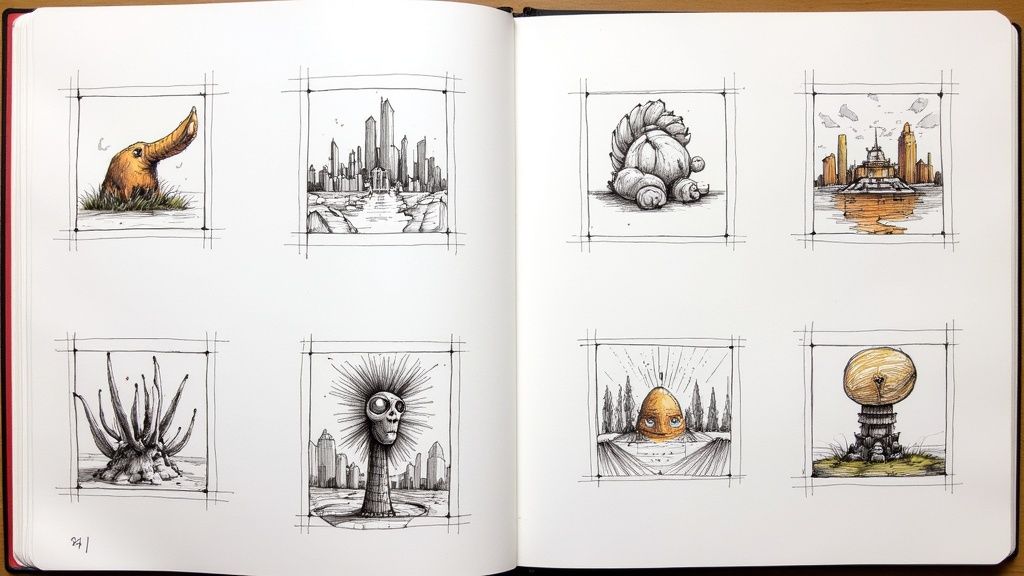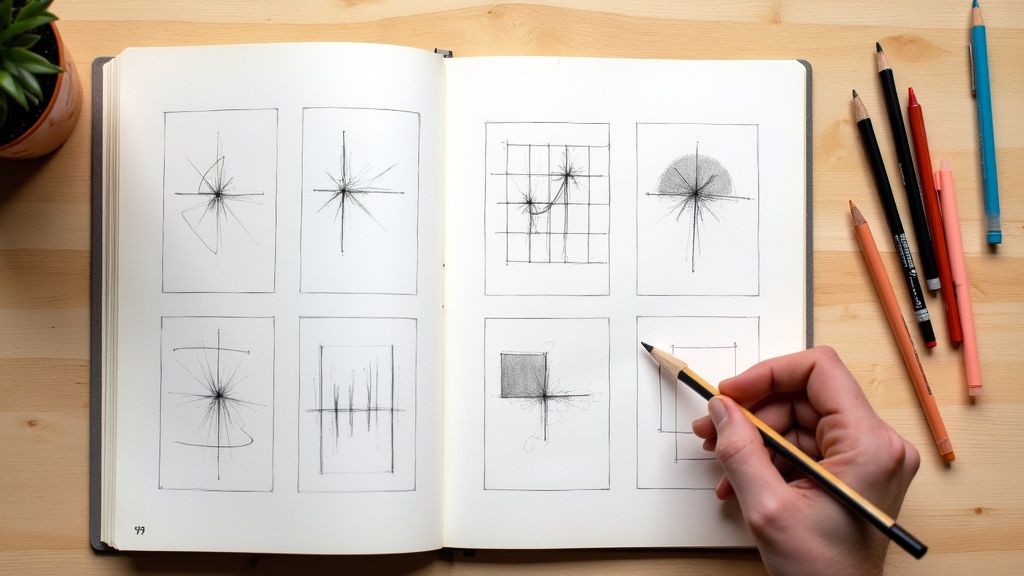The holiday season is a canvas of twinkling lights, cozy scenes, and joyful traditions, making it the perfect time to pick up a pencil or stylus. Whether you're a seasoned artist seeking a festive challenge or a beginner looking for simple yet charming projects, finding the right inspiration is key. This guide explores a curated list of Christmas drawing ideas, moving beyond the obvious to offer fresh perspectives and actionable techniques for artists at every level.
We will break down iconic subjects like Santa Claus, reindeer, and classic Christmas tree scenes into manageable steps. You'll find specific tips on everything from capturing the fluffy texture of a stocking to rendering the warm, inviting glow of a winter village at dusk. Our goal is to provide a comprehensive resource that helps you move from a blank page to a finished piece of holiday art.
This curated collection is designed to help you fill your sketchbook with the magic of the season, transforming familiar holiday themes into unique and personal works of art. Get ready to explore a variety of concepts that will keep your creative spirit bright.
1. Classic Christmas Tree Drawing: The Evergreen Centerpiece
The classic Christmas tree is arguably the most iconic symbol of the holiday season, making it a perfect starting point for your festive artwork. This subject goes far beyond a simple triangle; it's a fantastic exercise in texture, light, and composition. A detailed Christmas tree drawing challenges you to render everything from the prickly texture of pine needles to the reflective shine of glass ornaments and the soft glow of fairy lights. This versatility makes it an excellent subject for artists of all skill levels looking for engaging Christmas drawing ideas.
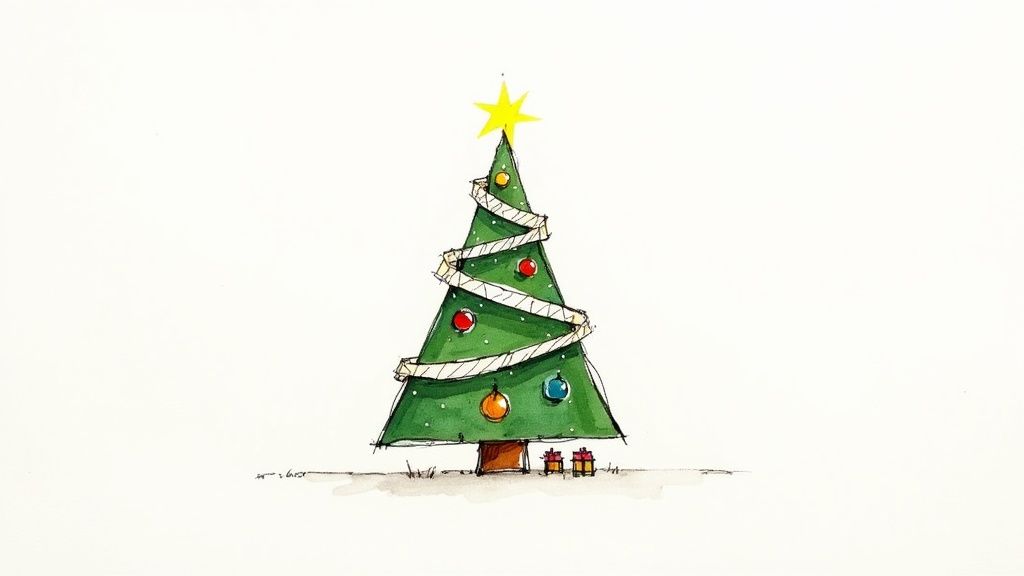
The true artistry lies in the details. You can see this approach in classic Hallmark Christmas cards and Norman Rockwell's heartwarming illustrations, where the tree feels like a living centerpiece of a festive scene. By focusing on how each element interacts, you can elevate a basic sketch into a rich and captivating illustration.
How to Create a Dynamic Christmas Tree Drawing
To avoid a flat, one-dimensional look, focus on creating depth and visual interest. Start with a basic cone shape, but add gentle, imperfect curves to the sides for a more natural silhouette. From there, build your drawing with layers of detail.
- Create Natural Branches: Instead of drawing perfectly even layers, sketch branches that jut out at varied angles and lengths. Add smaller branches extending from the larger ones to build realistic volume.
- Cluster Your Ornaments: Place ornaments in visual clusters rather than spacing them uniformly. Vary their sizes and shapes, tucking some partially behind branches to create a sense of depth. Place larger, more detailed ornaments closer to the foreground.
- Illustrate a Believable Glow: When adding lights, use warm colors like yellow, orange, or soft white. Draw a subtle, soft-edged "halo" or bloom effect around each bulb to suggest it's emitting light. This light should also cast soft highlights on nearby needles and ornaments.
- Add Shadows for Dimension: Use darker tones to add cast shadows beneath branches, ornaments, and garlands. This simple step makes the tree feel three-dimensional and anchors each object in place. When adding presents, consider their perspective and cast shadows on the floor to give them weight.
2. Santa Claus Portrait: Capturing the Spirit of Christmas
Drawing a portrait of Santa Claus is a timeless Christmas drawing idea that allows artists to capture the very essence of holiday magic. More than just a man in a red suit, a successful Santa portrait conveys warmth, kindness, and a hint of joyful mischief. This subject is a fantastic study in character design, texture rendering, and expressing emotion, challenging you to bring the legendary figure to life with his twinkling eyes, rosy cheeks, and iconic fluffy white beard.
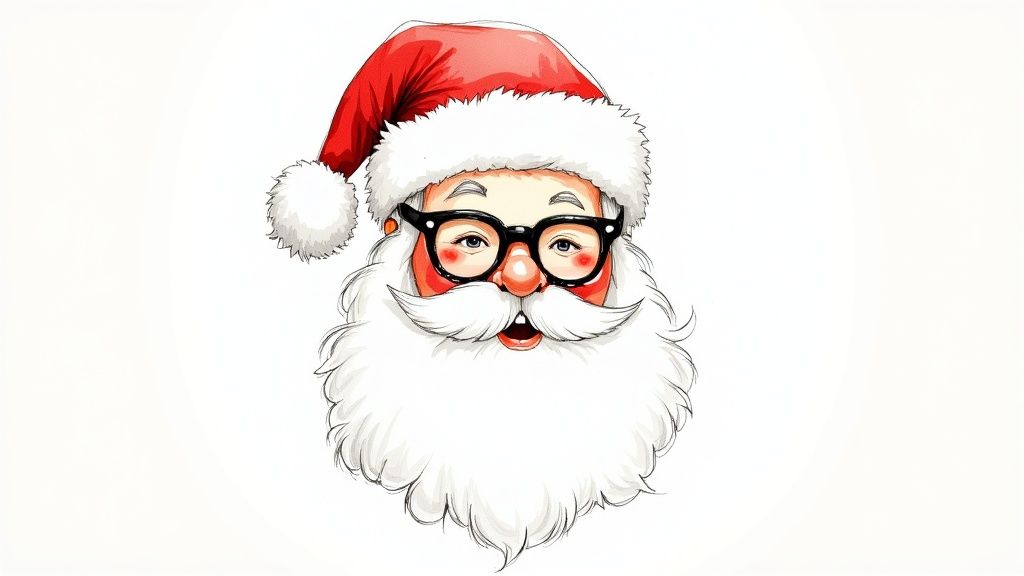
The modern image of Santa was heavily shaped by artists like Haddon Sundblom for Coca-Cola advertisements and Thomas Nast's earlier political cartoons, which established his jolly, grandfatherly persona. By focusing on these defining characteristics, you can create a portrait that feels both classic and personal, tapping into a universally recognized symbol of generosity and wonder. A well-executed Santa drawing can even serve as a central element for a more complex scene, like a bustling workshop. Learn more about drawing Santa's Workshop on drawinglist.com.
How to Create a Lifelike Santa Claus Portrait
To move beyond a simple caricature, concentrate on the details that give Santa his unique and friendly appearance. Start with a basic head shape and build layers of personality through texture and expression.
- Render a Full, Fluffy Beard: Avoid drawing individual hairs. Instead, use soft, overlapping circular or S-shaped strokes to build up the volume of the beard. Add light shading underneath the mustache and where the beard meets the face to create depth.
- Make His Eyes Twinkle: The eyes are key to his jolly expression. Draw them with a slight crinkle at the corners to suggest a smile. Add a small, bright white dot (a specular highlight) to each pupil to make them look wet and reflective.
- Give Him Rosy Cheeks: Use soft, circular shading with reds or pinks on the apples of his cheeks and the tip of his nose. Blend the edges smoothly to create a natural, healthy glow, as if he's just come in from the cold.
- Focus on a Warm Expression: Practice sketching different smiles separately. A genuine smile involves more than the mouth; it engages the entire face, especially the muscles around the eyes. Aim for a look that is both cheerful and kind.
3. Christmas Wreaths: A Symbol of Welcome and Eternity
A Christmas wreath, with its circular arrangement of evergreens, ribbons, and ornaments, is a powerful symbol of eternal life and a warm welcome. As a subject for your artwork, it offers a fantastic opportunity to practice symmetrical composition, organic textures, and intricate detail. Drawing a wreath challenges you to balance a structured, circular shape with the wild, natural feel of pine boughs, holly, and other festive elements, making it one of the most versatile Christmas drawing ideas.
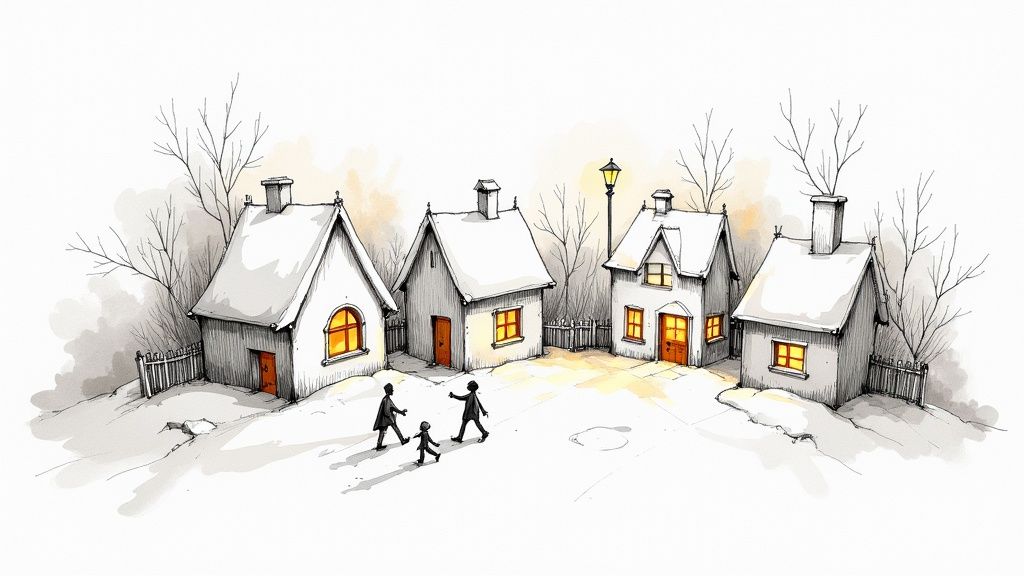
The beauty of drawing a wreath lies in its versatility. You can capture the rustic charm of a simple evergreen circle, the sacred look of an Advent wreath with glowing candles, or the opulent detail of a Victorian-era design dripping with bows and baubles. This subject is perfect for creating a focal point in a larger scene or a standalone piece that beautifully embodies the holiday spirit, much like the designs found in classic Christmas card drawing ideas.
How to Create a Lifelike Christmas Wreath Drawing
To make your wreath feel authentic and three-dimensional, focus on layering and creating a sense of organic chaos within its structured form. Begin with a light circle, drawn with a compass or by tracing a round object, to serve as your guide.
- Vary Leaf and Branch Directions: Draw pine needles and holly leaves pointing in slightly different directions. Overlap them to create a full, dense look rather than a flat, uniform pattern.
- Group Your Decorations: Arrange decorative elements like pinecones, berries, and small ornaments in clusters of odd numbers (e.g., three or five). This creates a more natural and visually appealing composition.
- Use Shadows for Depth: Add dark shadows between the layers of evergreen branches and underneath the decorations. This technique makes the elements pop and gives the wreath a realistic, three-dimensional quality.
- Make the Bow a Focal Point: A well-drawn bow can anchor your entire composition. Pay attention to the folds, highlights, and shadows in the ribbon to give it a sense of volume and texture.
4. Reindeer Illustrations: Capturing Mythical Grace
Santa's magical reindeer offer a fantastic opportunity to blend animal anatomy with Christmas mythology, making them a captivating subject for your holiday art. These creatures are more than just sleigh pullers; they are symbols of speed, wonder, and the magic of Christmas Eve. A detailed reindeer illustration challenges you to master quadruped anatomy while infusing the drawing with a unique personality, whether it's a powerful team leader or a gentle, shy fawn. This blend of realism and fantasy is one of the most rewarding Christmas drawing ideas for artists.

This subject has been immortalized by artists like the animators at Rankin/Bass Productions with Rudolph the Red-Nosed Reindeer and various Disney films. Their work shows how personality can be conveyed through expressive eyes, posture, and even the curvature of the antlers. By studying these examples, you can learn to create a reindeer that feels both majestic and full of character.
How to Create a Dynamic Reindeer Drawing
The key to a successful reindeer drawing is to balance realistic animal anatomy with a touch of holiday magic. Start with simple shapes to construct the body before adding details like fur texture and facial features.
- Build from Basic Shapes: Use ovals for the chest and hindquarters and connect them with a flowing line for the spine. This simple skeleton helps establish a natural, dynamic pose before you commit to detailed outlines.
- Study Real Deer Anatomy: Look at reference photos of real deer or caribou to understand their leg joints, muscle structure, and facial proportions. This will make your drawing more believable, even if you choose a stylized approach.
- Give Antlers Symmetrical Structure: Lightly sketch a central line for each antler to ensure they grow from the head at a similar angle. Build the tines (points) off these main beams, keeping the overall shape balanced for a visually pleasing look.
- Add Personality and Movement: Use large, expressive eyes and subtle facial expressions to give your reindeer character. Depict movement by drawing the legs in mid-stride and adding flowing lines to the harness or reins to suggest forward momentum. For a classic touch, a bright, glowing nose can immediately identify your creation as the famous Rudolph.
5. Christmas Village Scenes: Crafting a Festive Community
Capturing the charm of a Christmas village scene allows you to tell a broader story, weaving together architecture, landscape, and festive details into a single, cohesive narrative. This idea moves beyond a single subject and challenges you to create an entire atmosphere. Drawing a snow-covered village is a wonderful exercise in perspective, lighting, and composition, offering a rich source of Christmas drawing ideas for artists who enjoy world-building.
The nostalgic appeal of these scenes is evident in the works of artists like Thomas Kinkade, whose paintings glow with an idyllic light, and in the classic illustrations for Dickens' A Christmas Carol. These examples show how combining charming buildings with warm, inviting light sources creates a powerful sense of community and holiday spirit. You can explore more concepts like this by reading about drawing a winter village.
How to Create a Charming Christmas Village Scene
To design a village that feels both magical and believable, focus on composition and atmospheric effects. Start with quick thumbnail sketches to plan the placement of key buildings and establish a focal point before committing to a detailed drawing.
- Vary Your Architecture: To make your village visually interesting, include a mix of building styles and heights. Draw a tall church spire, cozy cottages, and quaint storefronts to create a dynamic skyline.
- Use Atmospheric Perspective: Create a sense of depth by making distant buildings lighter, less detailed, and cooler in color. This technique, known as atmospheric perspective, will make your scene feel vast.
- Add Warm Window Glow: Make the village feel alive by illustrating warm, yellow, or orange light spilling from windows and doorways. This creates a powerful contrast against the cool blues and purples of the snow and night sky.
- Include Human Elements: Add small figures walking down the street, a horse-drawn sleigh, or smoke curling from a chimney. These details add life, scale, and a narrative element to your scene, making it feel inhabited and festive.
- Balance Light and Shadow: Use cool tones for shadows cast on the snow to emphasize its coldness. The interplay between the warm light from buildings and the cool shadows on the ground will give your drawing incredible depth and mood.
6. Christmas Ornaments and Baubles
Focusing on individual Christmas ornaments and baubles is a fantastic way to practice rendering complex surfaces and light. These small, decorative pieces offer a universe of artistic challenges, from capturing the distorted reflections on a mirrored sphere to illustrating the delicate glitter on a handmade decoration. This specific subject is one of the most rewarding Christmas drawing ideas for artists who want to master light, shadow, and texture on a manageable scale.
The beauty of drawing ornaments lies in their diversity. You can find inspiration in everything from antique Victorian glass pieces with intricate patterns to sleek, modern baubles with minimalist designs. By isolating these objects, you can turn a simple still life into a detailed study of material properties, making your final illustration incredibly realistic and visually captivating.
How to Create a Stunning Ornament Drawing
The key to a believable ornament is capturing how it interacts with light and its environment. Instead of a simple colored circle, think of it as a small, reflective world. Start with a clean circular or custom shape and build your details from there.
- Study Real Reflections: Observe how light reflects on a real ornament. You’ll notice warped reflections of the room, the tree, and light sources. Sketch these distorted shapes onto your bauble to give it a realistic, mirrored surface.
- Use Highlights Strategically: Place a sharp, bright white highlight where the main light source hits the ornament. Use a softer, more diffused highlight on the opposite side to suggest ambient light. This contrast creates a convincing spherical shape.
- Vary Textures and Finishes: Challenge yourself by drawing ornaments with different surfaces. Try rendering a matte finish with soft, blended shading; a glittery texture with small, varied dots and specks; and a transparent glass effect with subtle colors and overlapping shapes.
- Group for Composition: Draw a cluster of ornaments hanging together at different depths. Overlap them and have them reflect each other to create a dynamic composition with a strong sense of three-dimensional space.
7. Christmas Angels: Messengers of Peace and Joy
Drawing a Christmas angel offers a beautiful way to capture the spiritual and serene side of the holiday. These ethereal figures, central to the Nativity story, provide a fantastic opportunity to practice figure drawing, fabric textures, and expressive symbolism. More than just a person with wings, an angel drawing is an exercise in conveying grace, peace, and light, making it a powerful and meaningful subject for your Christmas drawing ideas.
The artistic potential is vast, drawing inspiration from Renaissance paintings with their dynamic poses and rich drapery, to the sweet simplicity of Victorian Christmas card angels. By focusing on the interplay of light, form, and emotion, you can create a truly heavenly illustration that embodies the spirit of Christmas.
How to Create an Ethereal Angel Drawing
To give your angel a celestial and otherworldly presence, the key is to focus on softness, light, and graceful forms. Start with a flowing, gentle pose rather than a stiff, rigid one, and build your drawing with layers of delicate detail.
- Master Flowing Drapery: Study how light fabric drapes and folds. Use long, curving lines for the robes, adding soft shadows in the creases to create a sense of movement and volume. Avoid sharp, angular folds.
- Design Believable Wings: For realistic wings, look at the structure of large birds like swans or eagles. Sketch a primary bone structure, then layer feathers on top, making them larger at the tips and smaller near the body.
- Convey a Peaceful Expression: Focus on creating a serene facial expression. Use soft lines for the eyes, often drawn closed or looking downward, and a gentle, subtle smile. The goal is to express tranquility and grace.
- Create an Ethereal Glow: Use soft shading techniques, such as blending graphite or using light watercolor washes, to give the figure a luminous quality. Add a subtle halo or a soft-edged glow around the entire figure to emphasize its divine nature.
8. Christmas Stockings: A Personalized Holiday Tradition
Christmas stockings hung by the fireplace are a heartwarming and deeply personal symbol of the holiday, offering a wealth of creative possibilities for your artwork. Drawing stockings is an excellent exercise in capturing texture, personalization, and storytelling. This subject allows you to explore everything from the soft, fuzzy feel of felt or wool to the weight of hidden gifts, making it one of the most charming Christmas drawing ideas for artists who love adding character to their work.
The magic of a stocking drawing lies in its ability to tell a story about the people who own them. You can see this in classic children's book illustrations or cozy family portraits where each stocking reflects a unique personality. By focusing on these individual details, you transform a simple object into a narrative element full of warmth and anticipation.
How to Create a Charming Christmas Stocking Drawing
To make your stockings look authentic and full of life, focus on texture, form, and context. Start with the basic "L" shape of the stocking, but give it a soft, slightly lumpy silhouette to suggest it's made of fabric and filled with goodies.
- Illustrate Fabric Texture: Use your drawing tools to suggest different materials. For a knitted stocking, use curved, repeating lines to mimic yarn patterns. For a felt or velvet stocking, use soft shading and subtle highlights to create a smooth, plush surface.
- Add Personalization: This is where you can add real character. Embroider names onto the cuffs, add patches, sew on jingle bells, or create unique patterns. Each detail helps tell a story about its owner.
- Show the Weight of the Gifts: A stocking shouldn't look flat. Draw subtle bulges and creases in the fabric to indicate the shapes of the small gifts packed inside. Let a candy cane or a small toy peek out from the top for an extra touch of festive fun.
- Create a Cozy Setting: Place the stockings in a believable context, like hanging from a rustic wooden mantelpiece or a brick fireplace. Use warm lighting from a nearby fire to cast soft, flickering highlights and long shadows, enhancing the cozy atmosphere.
9. Nativity Scene Drawing: The Heart of the Holiday
For artists seeking to capture the spiritual core of the holiday, the Nativity scene offers a profound and compositionally rich subject. This drawing idea moves beyond secular symbols to depict the biblical story of Jesus's birth. It's a fantastic opportunity to practice figure drawing, portraiture, and narrative storytelling, challenging you to orchestrate multiple characters, animals, and architectural elements into a single, harmonious composition. The emotional depth and historical significance make it one of the most timeless Christmas drawing ideas available.
This powerful scene has been a cornerstone of Western art for centuries, famously interpreted by Renaissance masters like Caravaggio and Fra Angelico. Their works demonstrate how lighting, expression, and careful arrangement of figures can create a scene filled with reverence and quiet wonder. By studying these historical interpretations, you can bring a classical and poignant touch to your own artwork.
How to Create a Compelling Nativity Scene Drawing
A successful Nativity scene drawing relies on thoughtful composition and attention to historical detail. The goal is to guide the viewer's eye toward the central figures while creating a believable and atmospheric setting.
- Establish a Focal Point: Position the manger with baby Jesus as the undeniable focal point. Arrange Mary and Joseph closely around him, using their posture and gaze to direct attention inward. This creates a strong emotional center for the entire piece.
- Use Chiaroscuro for Drama: Employ strong contrast between light and shadow (chiaroscuro). A single, warm light source, such as a lantern or a divine glow from the infant, can illuminate the central figures while casting the rest of the stable into deep, dramatic shadow.
- Research for Authenticity: Add depth to your drawing by researching historical clothing and Middle Eastern architecture from the period. Instead of generic robes, try illustrating simple, draped garments. Portray a rustic stable made of rough-hewn wood or weathered stone.
- Vary Your Characters: Practice drawing figures of different ages and expressions. Illustrate the awe of the shepherds, the noble bearing of the wise men, and the gentle reverence of Mary and Joseph. This variety adds narrative richness and humanizes the scene.
Christmas Drawing Ideas Comparison Table
Item | Implementation Complexity | Resource Requirements | Expected Outcomes | Ideal Use Cases | Key Advantages |
|---|---|---|---|---|---|
Classic Christmas Tree Drawing | Low to Medium | Basic drawing materials | Recognizable festive symbol | Beginners practicing symmetry | Simple shape, creative decoration |
Santa Claus Portrait | Medium to High | Reference images, shading | Expressive, warm character portrait | Intermediate/advanced artists | Rich textures, emotional appeal |
Christmas Wreaths | Low to Medium | Templates, natural textures | Symmetrical organic composition | Exploring textures and circular forms | Flexible decoration, meaningful |
Reindeer Illustrations | Medium | Anatomy references | Dynamic animal figures with personality | Animal drawing practice | Movement and personality showcase |
Christmas Village Scenes | High | Architectural refs, planning | Nostalgic, story-rich environment | Advanced artists focusing on scene | Combines multiple skills, storytelling |
Christmas Ornaments and Baubles | Medium | Detail tools, observation | Detailed, textured reflective objects | Practicing light, material rendering | Reflection practice, pattern variety |
Christmas Angels | High | Figure and wing study | Graceful, spiritual human figures | Advanced figure and drapery study | Expressive, meaningful composition |
Christmas Stockings | Low to Medium | Fabric/textural study | Cozy, personalized decorative elements | Beginners to intermediate textures | Recognizable shape, intimate theme |
Nativity Scene | High | Multiple references | Complex religious narrative scene | Advanced artists with figure skills | Rich tradition, complex composition |
Keep the Creative Fire Burning All Year Long
The holiday season presents a boundless wellspring of inspiration, a vibrant palette of reds, greens, and golds just waiting to be captured on paper. As we've journeyed through this curated list of Christmas drawing ideas, from the intricate details of a village scene to the simple elegance of a bauble, the goal has been to do more than just replicate festive images. The real magic lies in using these prompts as a training ground for your artistic abilities.
Each idea we explored offers a unique opportunity to strengthen your core skills. Drawing a classic Christmas tree, for example, is a masterclass in rendering texture and creating depth through layering. Capturing a thoughtful Santa Claus portrait hones your ability to convey emotion and character, while illustrating a reindeer in mid-flight is a dynamic exercise in anatomy and motion. These are not just seasonal activities; they are fundamental building blocks for any artist.
From Holiday Doodles to Artistic Mastery
The true value of practicing these concepts extends far beyond creating a portfolio of yuletide art. The skills you cultivate here are universal and will profoundly impact every future piece you create, regardless of the subject matter.
- Composition and Storytelling: Arranging elements in a nativity scene or a bustling Christmas village teaches you how to guide the viewer's eye and tell a compelling visual story. This is a crucial skill for any narrative illustration.
- Light and Form: Rendering the soft glow of a candle on an angel's face or the reflective shine of a glass ornament provides invaluable practice in how light interacts with different surfaces to create form and dimension.
- Detail and Texture: Focusing on the woven fabric of a Christmas stocking or the delicate needles of a wreath builds your patience and technical precision, enabling you to add rich, believable detail to any drawing.
Think of each Christmas drawing not as a final product, but as a stepping stone. The techniques you use to draw a reindeer's antlers can be applied to drawing the branches of a tree in summer. The principles of composition from a festive scene can be used to lay out a futuristic cityscape.
Your Next Creative Steps
Do not let these Christmas drawing ideas be a once-a-year affair. The key to significant artistic growth is consistent, dedicated practice. Let these prompts be your launchpad. Challenge yourself to mix and match elements: What if a reindeer was peeking out from behind a Christmas tree? What would a stocking look like if it were decorated with tiny, intricate angel wings? The possibilities are limited only by your imagination.
As the festive season winds down, the most important thing is to maintain your creative momentum. Don't let your sketchbook close when the last of the decorations are packed away. The discipline and joy you've found in drawing this December can fuel your passion for the entire year to come. Keep that pencil moving, keep exploring, and watch as your skills blossom with every new page you fill.
Ready to move beyond Christmas drawing ideas and find daily inspiration? Visit Drawing List to access thousands of unique, creative prompts for every skill level. Keep your artistic journey going all year long with Drawing List.
